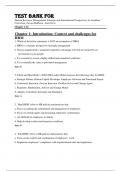Test Bank For Human Resource Management Strategic and International Perspectives 4e Jonathan Crawshaw, Pawan Budhwar, Ann Davis Chapter 1 -14 Chapter 1: Introduction: Context and challenges for HRM 1. Which of the below statements is NOT an assumption of HRM: a. HRM is a strategic perspective on people management b. That an organi zation’s sustained competitive advantage will only be secured by an investment in your people c. It is essential to secure a highly skilled and committed workforce d. It is essentially the same as personnel management Ans: D 2. Ulrich and Brockbank’s (2005) HR Leader Model proposes the following roles for HRM: a. Strategic Partner, Human Capital Developer, Employee Advocate and Functional Expert b. Conformist Innovator, Deviant Innovator, Problem Solver and Change Agent c. Regulator, Handma iden, Advisor and Change Maker d. Adapter, Consultant, Synergist and Champion Ans: A 3. ‘Hard HRM’ refers to HR policies and practices that: a. Focus on gaining the commitment and engagement of employees b. Focus on setting targets and measuring employees ’ performance c. Are difficult for employers to initiate d. Help develop a robust and tenacious workforce Ans: B 4. ‘Soft HRM’ refers to HR policies and practices that: a. Focus on the control and coordination of employees ’ work b. Emphasi ze employees’ compliance with organi zational rules and regulations c. Focus on developing employees ’ intrinsic motivation at work d. Promote a weak and feeble workforce Ans: C 5. Scientific Management proposes that greater workplace efficiency will be promoted by: a. Mechanizing the workplace, simplifying and routinising work and closely aligning pay with individual productivity outputs b. Mechani zing the workplace, simplifying and routini zing work and closely aligning pay with team -based productivity outputs c. Developing cross -functional teams and providing employees with greater decision -making responsibility and ownership d. Providing a greater role for research and development in organi zations Ans: A 6. Critical perspectives on HRM suggest that: a. HRM is an essential function for organi zational performance b. HRM is principally about gaining the control and compliance of employees against the strategic goals of the organi zation c. There is strong evidence for the impact of HRM on organi zational performance d. The main role for HRM is as an employee advocate Ans: B 7. HR outsourcing: a. Is about setting up your HR function in a foreign country b. Is about reducing the costs of the HR function c. Is an HR organi zing model that seeks to support both the strateg ic and operational roles of HRM d. Is more common in larger multinational organi zations Ans: C 8. PESTEL refers to the: a. Political, Economic, Social, Technological, Educational and Legal environment factors that affect a business and its HR policies and practices b. Political, External, Social, Technological, Educational and Legal environmental factors that affect a business and its HR policies and practices c. Political, Economic, Scientific, Technological, Educational and Legal environmental factors that affect a business and its HR policies and practices d. Political, Economic, Social, Technological, Environmental and Lega l factors that affect a business and its HR policies and practices Ans: D 9. The ‘triple bottom line ’ refers to an organi zation’s: a. Economic, HR and CSR performance b. Economic, social and environmental performance c. Business, HR and environmental per formance d. Social, environmental and sustainability performance Ans: B 10. The CIPD suggest that HR professionals require the following skills/traits to be a successful HR practitioner: a. Curious, decisive, collaborative, credible b. Autocratic, egoistic, autonomous, risk taking c. Affable, generous, easy going, caring d. Risk averse, introverted, conforming, agreeable Ans: A Test Bank Chapter 2: HRM and firm performance 1. What is meant by strategic human resource management? a. A field that deals with managerial decisions and actions to improve the long -run performance of organi zations b. A fundamental framework through which an organi zation can assert its vital continuity c. The formulation of organi zational missions, goals and objectives d. The overall direction the organi zation wishes to pursue in achieving its objective through people Ans: D 2. What does the resource -based view argue? a. It argues that the development of a number of interrelated HRM processes will improve organizational performance b. It argues that HRM influences performance according to the human capital held by the organi zation c. It argues that the development of mutual commitment within the organi zation will eventually influence performance d. It argues t hat the treating of employees as partners in the organi zation will ultimately improve performance Ans: B 3. What is a black -box mechanism in HRM? a. It is the mechanism that indicates how HR practices are selected b. It is the mechanism that connects HR practices with business strategies c. It is the mechanism through which HR practices influence business performance d. It is the mechanism that indicates how business strategies are selected Ans: C




